I was four when the 1994 blizzard silenced Louisville. I remember trudging through the snow with my brother, and how the powder’s surface must have been at my chest. Looking back, the snow was both exciting and familiar. Even though I may have only experienced snow a few times before, it didn’t feel foreign. It was like it was a part of me. In that moment, I was nature.
It’s easy to forget sometimes, that we’re nature. That we come from the same place as weeds and mosquitoes and polar bears. It’s easy to forget, because what do you more commonly see: a kid in a restaurant hypnotized by the glow of a tablet, or a kid sitting on a stump in the forest, enjoying a peanut butter and jelly sandwich?
 |
The latter is how a group of nine three- and four-year-olds often spend their mornings. On a freezing but sunny December morning, the kids begin their day bundled up in pants, hats and gloves, which make up for their tiny size with bold purples, greens, pinks, reds and yellows. Carrying backpacks that showcase Elmo or Paw Patrol, the preschoolers march, meander, skip and tumble down a leafy path (falling down seems to be the thing to do), over sticks and under boughs. Their destination is an open area surrounded by stumps of ash trees, logs and large piles of winter-shriveled sticks and leaves. The little humans are in their classroom.
The Thrive Forest School, a preschool at Creasey Mahan Nature Preserve in Goshen, began classes in September, after a muddy summer camp left some parents wanting more and others wanting in. Their desire is a child-led, nature-immersion education. It’s a growing, now close to 300-school movement in the U.S., modeled after the European forest schools that originated in the ’50s and continue to garner support from education studies and childhood experts. In forest kindergarten (the technical term that includes children ages three to six), school happens outside, where toys are mud and sticks, music is one’s own voice and games are imagination. “Bring them inside and they start to bounce off the walls,” says Creasey Mahan education director Ryan Devlin, “so we just take the walls away.”
Devlin spent the last 10 years as an actor. (You may have seen him on Brothers & Sisters, Grey’s Anatomy, Veronica Mars or Cougar Town.) A few years ago, he and his wife, screenwriter Kara Holden, were living as new parents in Santa Monica, California, wanting their son’s upbringing to resemble the outdoorsy experiences they enjoyed, away from the bustling, season-less Los Angeles area. Devlin, who grew up in Michigan, says his childhood was full of “exploring, making up stories, being creative, letting kind of our inner-self come out in ways that you can’t do when you’re guided so strictly by a piece of technology or by a tight pedagogical philosophy.” He studied forest preschools for two years, at Wauhatchie School in Chattanooga, Tennessee, and Cedarsong Nature School, one of the country’s first forest kindergartens, founded in 2006 outside Seattle. Holden, who grew up in Crestwood, got a job last year in the film department at the University of Louisville. Having fallen like an acorn for the nature preserve near their new home in Goshen, Devlin approached Tavia Cathcart Brown, executive director of the nonprofit Creasey Mahan, about starting a school. Brown, whose sunny demeanor and whimsical voice could pass for a wood fairy’s, thought it sounded wonderful.

The first day I observe the kids, frost has blanketed the ground. One boy picks up a stick wrapped in crystal circuitry, studies it for a moment, then licks it, noticing how the patterns disappear at the same moment his tongue feels cold.
“Is it warm or cold?” asks Devlin, squatting down at the kid’s level.
“Cold.”
“Why did your tongue melt it?”
“Because it’s cold.”
“Because your tongue is cold?”
“Mmmhmm.”
“It’s probably cold now. Do you think maybe your tongue melted it?”
“Mmmhmm.”
Devlin’s attention is diverted, and he says to some other kids, “You can throw yourself on the ground but not on top of a person.”
Other outdoor preschools exist in Kentucky, such as Natural Start Preschool outside Cincinnati, and Red Oaks Forest School at Red River Gorge. There are forest meet-up groups locally, and Jefferson Memorial Forest has programming for preschool-aged kids. Other area preschools emphasize the same concept of child-led outdoor play, but none in Louisville is set up like Thrive. The class meets from 9:30 a.m. to 12:30 p.m. Tuesdays, Thursdays and Fridays, if parents opt for three days. The group starts by the playground at the entrance of the 170-acre forest, with a morning song led by instructors Donna Brown and Kathryn Keefe. The kids’ helium-pitched voices sing along: “Down is the earth. Up is the sky. Here are my friends and here am I. Good morning, dear earth. Good morning, dear sun. Good morning, dear trees and flowers, everyone.”

Then they make the descent to their class area — which can take 10 minutes or an hour, depending on what kind of wonders (animal tracks, bugs, sticks) capture the kids’ attention. “We’re having some challenges with being gentle today,” Brown says in a soft voice. Moments later, she sings, “Sticks on the ground while we’re walking.”
“There’s no punishment, just modeling,” Brown later tells me. She used to be a teacher in the Waldorf style, which stresses a similar child-inquiry learning and an emphasis on outdoor play. Prior to joining Thrive, she spent 15 years homeschooling her son with special needs, and they’d often spend time outside. “The children that have a lot of energy, they can really express themselves (in nature) and not feel like, oh, you need to behave,” she says.
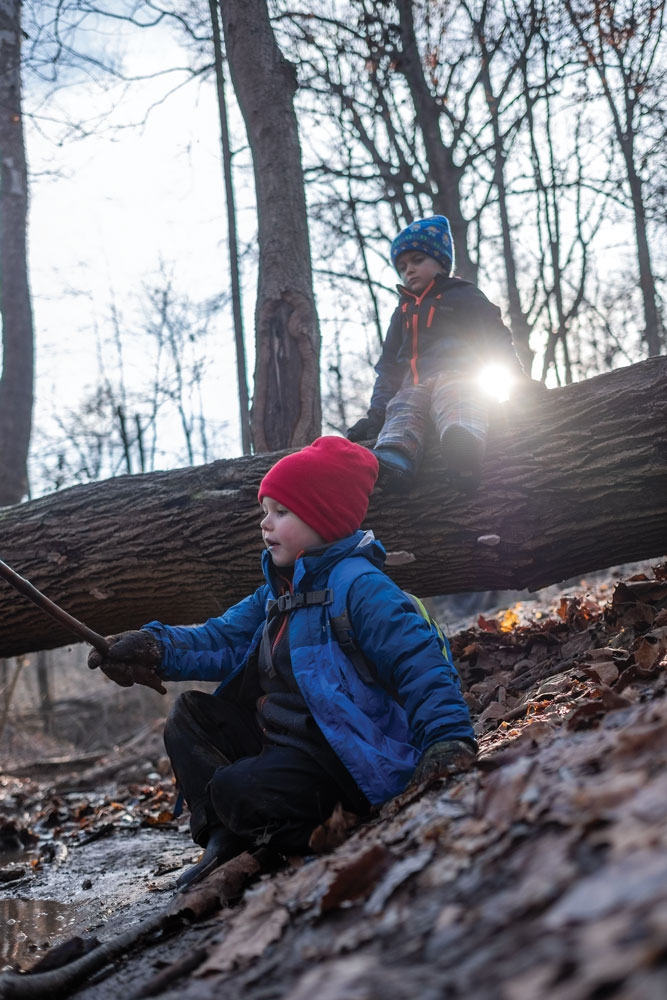 |
At the classroom site, the students are deflated to learn that the muddy creek has frozen and they can’t easily mix up the mud-and-chalk magic potions they’ve been concocting. “We’ve got tools, no toys — shovels, chalk, rakes, buckets, bug houses,” says Devlin, whose son is now four and attends Thrive. The kids will gather around a campfire for a snack and a naturalist-themed story, about a deer walking in the woods and coming upon some frost, for example. “Some of them just want to sit and kinda stare, you know, and we don’t go over and say, ‘It’s song time now,’” Devlin says. “If they just want to be contemplative, that’s fine. If they want to be rambunctious, that’s fine. There’s no ADHD out in the forest. It’s just kids being kids, and so if they want to get energy out, they can. If they want to sit and work on a fairy house, they can.”
Along with the rocks, pinecones or other discoveries that may make it into the students’ backpacks, they carry a full change of clothes, extra layers, extra hats and mittens, and a water bottle with warm water or tea. For the majority of the time, though, even on the gloomy day when I visit, the kids are generating so much heat that the gloves and hats come off. A couple of Thrive’s mottos are: “Your child will come home dirty or your money back” and “There’s no such thing as bad weather, just bad clothing choices.” Of course, as Devlin says, it’s not a boot camp, and the group goes inside to the nature center if the weather becomes hazardous or if the temperature dips to 15 degrees or below.
“We love our sunny days,” Devlin says, “but we love our rainy days. The mud, the sounds of the raindrops on the tree canopy, the rings that it makes in the pond or in the stream, the rivulets that form. We’re learning: Worms come up. Why do worms come up? Well, their wormholes are filled with water, they need to breathe, so they come up. Nobody knows why worms come up when it rains, but our kids know because we experience it.
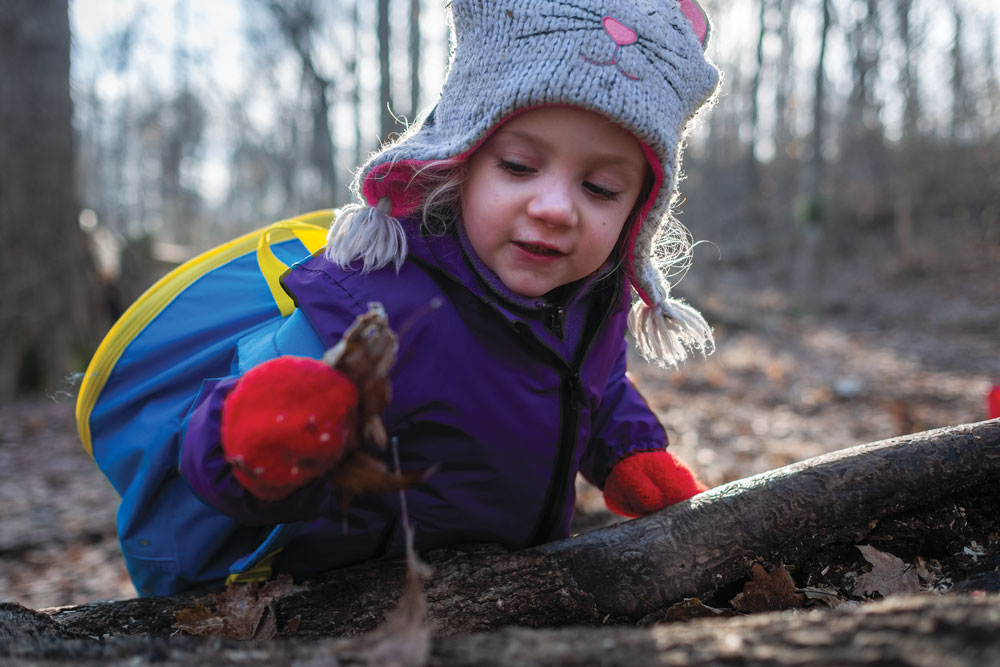
“There’s a difference between teaching and learning,” Devlin continues, “and for children, their work is play. That’s how they learn about their bodies. That’s how they learn about cause and effect. That’s how they learn about social dynamics.” He also mentions confidence, resilience and creative problem-solving, so-called “soft” skills that many experts believe can help the hard skills (like reading and math) sink in better in later years. And in the woods, it’s hard to avoid science lessons. Why did the mud freeze? Why does the creek ripple when you drop a stone in it? Why does a leaf fall to the ground slowly and a stick falls quickly? Why do they fall to the ground at all?
Risk is also a major theme at Thrive. Devlin says the instructors remove hazards, like broken logs, glass or boards with exposed nails. “But risk abounds in our forest classroom. We’ve got a log bridge that goes over a stream with a three-and-a-half-foot drop. There’s risk there. There’s uneven surfaces. There’s stumps to climb,” Devlin says. “All of those are manageable levels of risk, so a child can take a look and say, ‘Oh, I don’t feel comfortable walking across that, but maybe I’ll crawl across it.’” Tavia Cathcart Brown recalls a student doing just that. On the first day the girl arrived, she had an adult carry her across the log. By the next day, she was running across it.
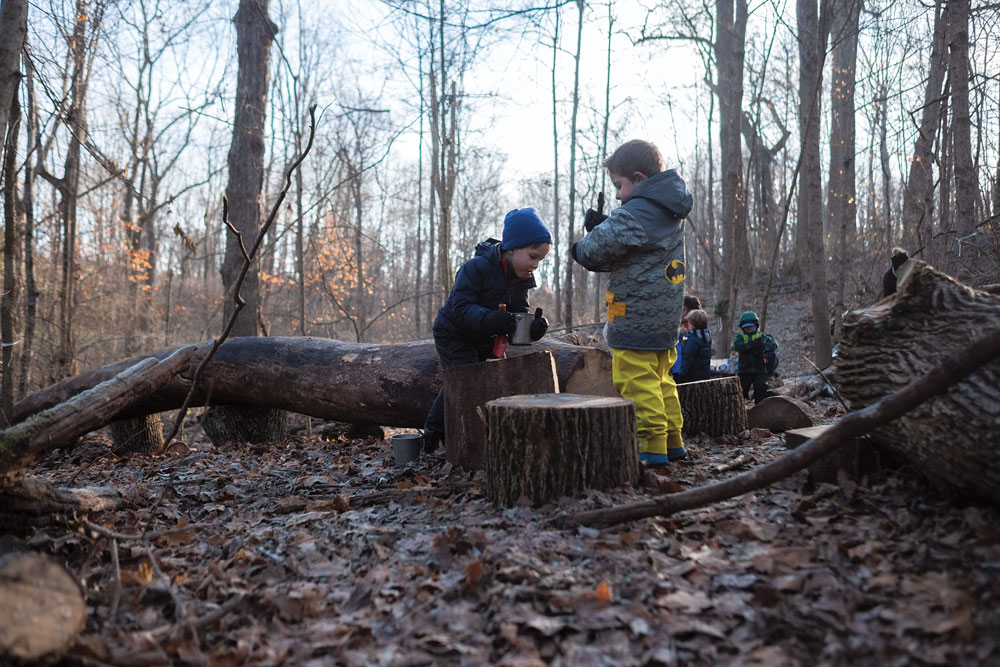
Tricia (who asked that her last name not be used) has her son at Thrive, she says, because he’s not a “sit-at-a-desk” kind of kid. “I send him in clean, he comes out covered in mud with, like, the biggest smile on his face,” she says. “He looks forward to it every day, regardless of weather.” Chelsey Burkitt-Harris, whose three-and-a-half-year-old son Palmer attends Thrive, says she wanted him to be able to be outside and play with other kids. “I just see the value in that over a brick-and-mortar classroom,” she says. “They get to see the changes day to day and from season to season in a very real, tangible way.”
Brown mentions the term “nature deficit disorder,” which the author Richard Louv coined in 2005 with the book Last Child in the Woods, describing the costs of nature deprivation as everything from obesity to short attention spans. Devlin says that, since the school got a lot of media coverage in December, several educators have reached out and asked if they could observe or train at Thrive. “North Oldham (schools are) right here,” Devlin says. “There may be an opportunity to get some of the older kids out here as well.” And next year, Thrive plans to go to five days a week.
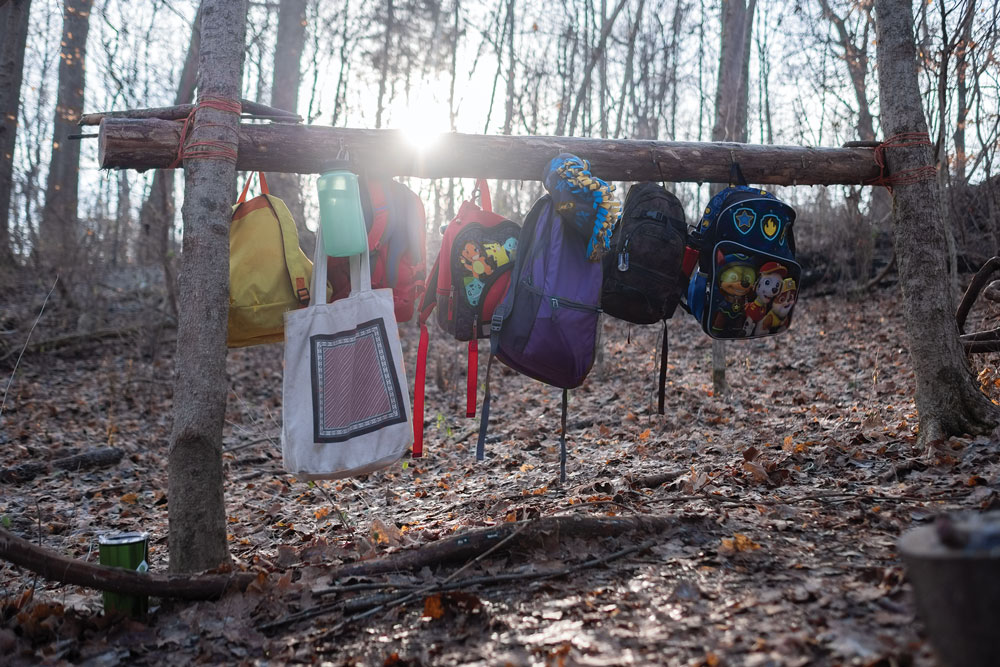
After a calm period of the kids sitting like literal bumps on logs and munching on Smucker’s Uncrustables PB&J sandwiches (and, in some cases, seeing how many Goldfish crackers one can stuff inside the sandwich pockets) their energy levels rise almost in unison. Several of the students get instructor Kathryn Keefe to accompany them on a hike. She glances behind to note the number of joiners, and one boy says, “I count one, two, three, four, five, six.”
“And how many with me?” Keefe asks him.
“Seven!”
“The more familiar they get with the surroundings, the more they want to go out more,” Keefe says to me. “We’ll do this every now and then. It helps release energy, too.”
Keefe has been a Montessori teacher and is a naturalist, so when Thrive was getting started in the woods where she grew up, she says, she wanted to be a part of it. “They’re so much happier out here than they are, at least from my experience, in a classroom setting,” she says. “This is so much freer and easier to maintain.”
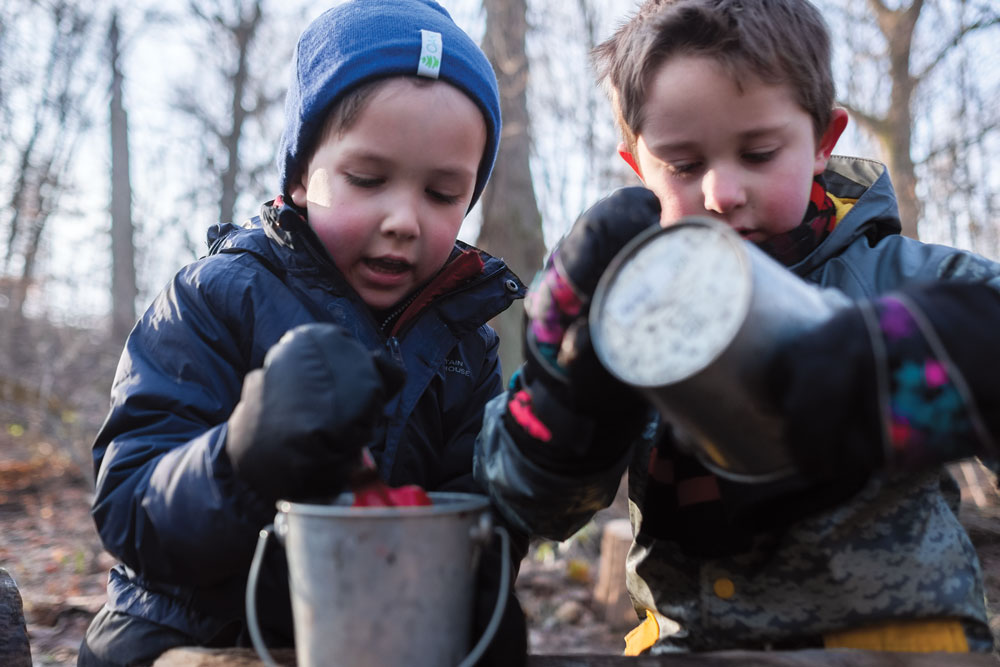
After making it through the woods to a dirt path, a few boys and girls stop at a dirt mound and start throwing clumps in all directions. One boy balls up traces of snow and pelts Keefe.
“Let’s not throw mud at each other, friends,” Keefe says in a kind voice.
The group turns a corner and the kids start sprinting full speed ahead, arriving back at the classroom that quickly turns into an ice cream parlor (crushed ice from the stream), cookie bakery (with pieces of a thin log cut into discs) and house (formed by varying sizes of sticks and logs). Just as everyone is deep in play, salt-sized snowflakes begin flurrying down into the classroom, causing some kids to shriek.
“It’s snooooowwwing!!!!!”
This originally appeared in the February 2019 issue of Louisville Magazine under the headline "In the Woods." To subscribe to Louisville Magazine, click here. To find us on newsstands, click here.
Photos by Joon Kim, studiojoon.com



